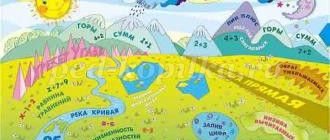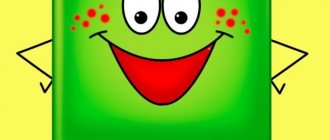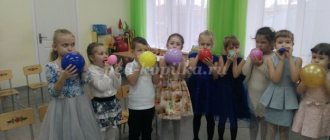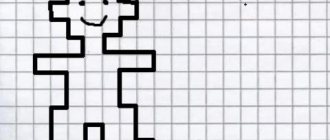8909_konspekt otkrytogo zanyatiya 2015.docx
Topic: “An interesting journey to the land of Mathematics.” Program content: Educational tasks: Develop logical thinking, the ability to think, reason - Develop computing skills; - exercise children in forward and backward counting within 10; — Strengthen knowledge of numbers. Developmental tasks: - create conditions for the development of logical thinking, intelligence, attention; - develop imagination, ingenuity, visual memory; - contribute to the formation of mental operations, speech development, and the ability to argue one’s statements. Educational objectives: - To cultivate interest in mathematical knowledge; - develop the ability to understand a learning task and carry it out independently. Demonstration mat erial: chest, letters, names of stations, letter from the Queen of Mathematics, sticks, drawn pyramid, ball, presentation. Methodical techniques: - Game (surprise moment); - verbal (reading a letter, questions, conversation, logical tasks); - visual (demonstration material) - lesson analysis, encouragement. Progress of the lesson: - Guys, this morning I came into the group and saw this chest on the table. I wanted to open it, but it won’t open. I was very upset. Then I saw this letter and thought that I would read it with you. Let's read and find out what is written there. “Dear guys, this chest is for you, and what can you find out when you open it. But it doesn't open with a key. You need to go on a journey through the math stations, where I have prepared different tasks for you. You will need to add, subtract, solve fun problems, think and reflect. For each completed task you will receive a letter. Then make a word out of all the letters. If you guess the word correctly, the chest will open. These tasks are for the smartest and most resourceful! (Queen of Mathematics). - Well, guys, let's go on a trip to the mathematical stations? Aren't you afraid of difficulties? (No) - Do you like to travel? (children's answers) - I also really like to travel! We'll go by train. - - Dear passengers! Take your tickets and take your seats in the carriages. Have you noticed that the tickets are unusual? How can you find out? What's your place? tickets are cards with drawn geometric shapes. - Guys, look at each other, are you in the right place? (Yes) - Well done! Go! (music from the song sounds: “We are going, we are going”). - Attention! Attention! Stop! Guys, let's read the name of the station? — Station 1: “Warm-up.” (The task is written under the name of the station) Game: “Straight and reverse counting” with a ball. — Guys, we’ll play the game in a circle. (Children form a circle, the teacher throws the ball one by one, names the number, the child must continue counting forward (reverse). - Well done! You completed the task, you get a letter. What is this letter? (M.) - That's right, the letter M. Let's continue our journey! Take your seats! Let's go! (music plays) - We've arrived! Let's read the name of the station? - Station 2: “Logical". (The task is written under the name of the station) Solving logical problems. - We will perform the task at the tables. (The teacher reads the tasks, children must give the correct answers.) 1. Mom has a cat Fluff, a dog Buddy and a daughter Dasha. How many children does mom have? (1) 2. On one shore there are chickens, on the other there are ducklings. There is an island in the middle. Who can swim to the island faster . (Ducklings) 3. The dog Mickey gave birth to three white and two black kittens. How many kittens were born to the dog Mickey? (5) 4. There are 3 apples and 2 pears on the table. How many vegetables are there on the table? A- f ruktov? ( the question is asked when the first one is answered) (5 fruits, 0 vegetables) 5. There is an oak tree in the field. There are 3 branches on an oak tree. There are three apples on each branch. How many apples are there in total? (apples don’t grow on oak trees) 6. Two girls went into the forest to pick mushrooms, and two boys met them. How many children go to the forest? (4 children) 7. There are four children in the family: are there the same number of sisters? How many brothers are there in the family? (No brothers) 8. Peter is the son of Sergei, and Sergei is the son of Fyodor. Who is Peter Fedor related to? (grandson) 9. Grandmother put 10 pears on a plate. After the grandchildren took 1 pear from the plate, there were 8 pears left. How many grandchildren does grandma have? (two) - Well done, you did a great job with this and the tasks! Get a letter! What letter? (O) - That's right, the letter O. You noticed that you were given two letters O, which means there are two letters O in the word that you will need to guess. We continue our journey. Take your seats. (music sounds) - We've arrived! What kind of station is this? — 3rd station: “Geometric”. (The task is written under the name of the station) Build geometric shapes from sticks. - We will perform this task on the mat. To do this, you need to divide into 3 groups. (Children are divided into 3 groups, each group is given a task). Task for the first group: “Make 2 equal squares from 7 sticks” Task for the second group: “Make 3 equal triangles from 7 sticks” Task for the third group: “Make 4 equal triangles from 9 sticks.” (children complete tasks in groups, then check with each other whether the task was completed correctly) - Well done, you completed this task too! Here's a letter for you! (L) - That's right, this is the letter L. And our journey continues. (children take their seats, music sounds) - We’ve arrived! Station 4: "Approximate". (The task is written under the name of the station) Solve the example and write down the answer. - Guys, look, here is a pyramid with unsolved examples, to get the letter we need to solve all these examples. (A pyramid with examples is drawn on the board; children take turns going to the board and solving one example at a time). - Well done guys, you did a great job with this task and for this you will receive two letters. - What letters are these? (D, C). - Let's move on, take your seats. (music sounds) - 5 Station "Terminal". (The task is written under the name of the station) Count the objects and find the corresponding number. Children are offered a multimedia presentation. Children take turns counting the objects and clicking on the corresponding number. - Well done guys, you completed all the tasks! - Get the last letter. (Y) - Correctly, this is the letter Y. For each task you received letters. It's time for us to return. Take your seats on the train. (music plays) - Here we are in the group, now we need to open the chest. And what do we need for this, please remind me. Of course, the letters must be arranged correctly to form a word. Let's remember what first letter we received? (M) - Which second? (O) We received two of them. I immediately lay out two letters O. - Third? (L) - Fourth we had two letters? (D, C) - Fifth? (Y) I lay out all the letters. It turns out this series of letters: M O O L D T S! - All we have to do is read the word. (children read the word) (WELL DONE) - Well done, guys! Now let's try to open the chest. The child opens the chest. There's a treat there - Did you guys enjoy the trip? Were the tasks difficult? — Do you still want to go to the land of Mathematics? - Help yourself, please!
Abstract of the GCD “Fun Mathematics”
Municipal autonomous educational institution
"Primary secondary school No. 12"
Abstract of the educational activity in the educational field “Cognitive development: in the second mixed-age group on the topic:
“Fun Mathematics”
1.
Type of lesson
- learning new material.
2. Integration of areas:
cognitive development, speech development, social-communicative, physical.
3. Form of educational activity:
problematic situation.
4. Goal::
To develop children’s
interest in independently solving cognitive and creative problems.
5. Tasks:
Educational: practice comparing objects by length, consolidate the name of geometric figures, consolidate forward counting to 10 and backward counting from 10 to 0, be able to name neighboring numbers, the next and previous number, learn to navigate in space.
Developmental: develop logical thinking.
Educational: cultivate kindness and responsiveness.
6. Equipment:
musical accompaniment, pictures of wintering birds, sheets A/4.
Equipment and materials: strips of different lengths, geometric shapes, numbers written on flowers (a set for each child or one set for the whole group), images of fairy-tale characters: mice, Kolobok, Dunno, mosquito 7. Methodological techniques:
use of TSO, visual material , use of gaming technologies, conversation, questions, techniques of health-saving technologies (change of activities, physical exercise)
8. Preliminary work: listening to fairy tales, building games with cubes. individual work when free from GCD, during games of any kind
9.
Duration – 20 minutes (middle group), 25 minutes senior group, 30 minutes (school preparatory group)
10.
Participants - students
11.
Age of students: 4-5, 5-6 years, 6-7 years
12.
Lesson structure:
| Lesson stage | Content | Time |
| Part I | Introductory part | 2 minutes. |
| Part II | Main part | 14min. 19 min. 24 min. |
| Part III | Final part | 4 min. |
Part I:
introductory part
Educator:
The song “Fairy tales walk around the world” sounds, children enter the group and stand around the teacher
Educator:
Guys, do you like fairy tales?
Children: (children's answers)
Educator:
Today we will go on a journey and meet our old acquaintances - heroes of various fairy tales. Do you know that magpies bring news on their tail? Today a magpie flew to me and told me about the problems that the heroes of various fairy tales had. Are you ready to help them?
Children: (children's answers)
Part II:
main
Educator:
There is a house on a hill, we’ll count all the heroes and then we’ll find out who lives in the house. What kind of house is this? Can you tell me? Who was first and who was second, etc. How many inhabitants are there in the house?
Children: (children's answers)
Attention, the first fairy tale begins
Two paths lead to , one long and the other short.
The mouse doesn’t know which path is the fastest to get to the tower, but
long or short:
Children: (children's answers)
Yes, guys, that's right, it's faster for a mouse to run along a short path to
house. How can we know which strip is longer and which is shorter? (Measure, place strips on top of each other)
Educator:
Well done guys, you correctly indicated the path, which is shorter, so the mouse got to
the little house ,
and began to live there, sing songs, and meet his friends.
Educator:
In this fairy tale we meet a hero: he is round, not a ball, he has traveled so many roads, overcome all obstacles, but someone was more cunning. What kind of hero?
Children: (children's answers)
Educator:
Maybe we can save Kolobok?
(Yes).
To rescue Kolobok from the fox’s mouth, we need to find geometric figures and arrange them in accordance with my clues. (find geometric shapes and lay them out at the request of the teacher)
Fizminutka:
The song “About the car” is playing
"We're getting higher"
We are getting higher and higher, We reach the roofs with our hands. We went up for two counts, three, four - hands down. (Stretching on toes with arms raised up and lowered in an i.p.) (Children of the middle subgroup go to the reception room and play with the junior teacher) Educator:
He is proud of his hat, he lives in a city where everything is buried in flowers, he is reputed to be a big entertainer, but he himself knows nothing. Who is this - have you guessed?
Children: (children's answers)
Educator:
Guys, Dunno is such an inventor, he decided to play a joke on his friends, but the friends were upset when they saw that the numbers on their houses were mixed up. I suggest you find the numbers and put them in order (Game “The Numbers Are Lost” (the numbers are not in order)
Invite children to find the numbers depicted on the flowers and sort the numbers in ascending order from one to ten.
Educator:
Ordinal counting, and now backwards (children count).
Educator:
Name the previous and next number, numbers 5,7,9,8,
compare the numbers 5 and 3 (name the numbers)
Educator:
Compare the numbers 4 and 4 (prove that these two numbers are the same)
Educator:
You completed the task.
(Children of the senior subgroup go to the reception area and play with the junior teacher)
Educator:
Who is flying towards us?
Who is not afraid of anything and is ready to fight the villain? (Mosquito)
Be careful not to get caught in the spider's web. Game for spatial orientation "Be careful"
III
:
final (children from both groups are invited to the group)
You were attentive and friendly and therefore were able to help the fairy-tale characters. What new have we learned today? What tasks did you and I perform? (children's answers).
Let’s say “Goodbye” to the heroes of fairy tales, and I say “Thank you” for your attentiveness and responsiveness.




